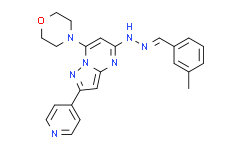| Cas No.: | 1232221-74-7 |
| Chemical Name: | (E)-4-(5-(2-(3-Methylbenzylidene)hydrazinyl)-2-(pyridin-4-yl)pyrazolo[1,5-a]pyrimidin-7-yl)morpholine |
| Synonyms: | APY0201;(E)-4-(5-(2-(3-methylbenzylidene)hydrazinyl)-2-(pyridin-4-yl)pyrazolo[1,5-a]pyrimidin-7-yl)morpholine;APY-0201;4-(5-{2-[(3-methylphenyl)methylidene]hydrazin-1-yl}-2-(pyridin-4-yl)pyrazolo[1,5-a]pyrimidin-7-yl)morpholine |
| SMILES: | O1C([H])([H])C([H])([H])N(C2=C([H])C(N([H])/N=C(\[H])/C3=C([H])C([H])=C([H])C(C([H])([H])[H])=C3[H])=NC3=C([H])C(C4C([H])=C([H])N=C([H])C=4[H])=NN23)C([H])([H])C1([H])[H] |
| Formula: | C23H23N7O |
| M.Wt: | 413.475 |
| Sotrage: | 2 years -20°C Powder, 2 weeks 4°C in DMSO, 6 months -80°C in DMSO |
| Description: | APY0201 is a potent PIKfyve inhibitor, which inhibits the conversion of PtdIns3P to PtdIns(3,5)P2 in the presence of in the presence of [33P]ATP with an IC50 of 5.2 nM. APY0201 also inhibits IL-12/IL-23 production. |
| In Vivo: | Oral APY0201 at a 30 mg/kg dose shows significant reduction of IL-12p70 production (78% inhibition relative to that of the vehicle control), which implys that the inhibitory potential of APY0201 against IL-12 is confirmed in the animal experiment[1]. |
| In Vitro: | APY0201 works differently from anti-IL-12/23 antibodies and acts by inhibiting production of these proinflammatory cytokines with characteristic selectivity over other cytokines, including tumor necrosis factor-alpha (TNF-α). In stimulated thioglycollate-induced mouse peritoneal exudate cells (TG-PEC), APY0201 strongly inhibits IL-12p70 and IL-12p40 production, with IC50s of 8.4 and 16 nM, respectively. APY0201 also inhibits IL-12p40 at 99 nM in human PBMC. APY0201 shows significant selectivity for the production of IL-12p70 and IL-12p40 over TNF-α, and this selectivity is maintained across species[1]. |

 To enhance service speed and avoid tariff delays, we've opened a US warehouse. All US orders ship directly from our US facility.
To enhance service speed and avoid tariff delays, we've opened a US warehouse. All US orders ship directly from our US facility.




















